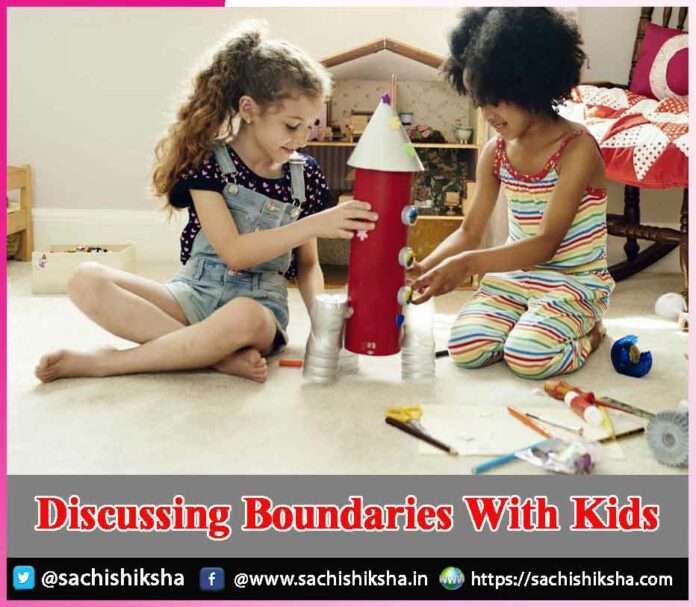Discussing Boundaries With Kids
Introduction: Establishing healthy personal limits, as well as possessing the ability to recognize and honor others’ boundaries, is critical for developing solid relationships based on mutual respect. However, managing boundaries might be difficult. And if the parents aren’t used to scrutinizing their own, it can be unsettling to do so as a grownup.
That is why it is critical to start teaching children about appropriate boundaries at an early age. The sooner kids understand the boundaries they set and the value of respecting others’, the simpler it will be for them to establish and maintain productive connections as adults.
Table of Contents
Boundaries are Essential:

Self-esteem & Self-worth:
When children develop and respect limits, they gain self-esteem and self-worth. Furthermore, recognizing their limits can help children form good connections and prevent being taken advantages of by individuals in later life. Parents can establish limits for their children in order to encourage healthy behaviour while establishing an appropriate and consistent lifestyle.
Modelling Boundaries:
When modeling boundaries, it is important to keep calm and consistent—after all, if kids are going to understand boundaries, they must first aim their limits. Challenging limits is a normal aspect of developing and growing up because children seek to discover what lengths they can reach. Indeed, it is the responsibility of parents to demonstrate to children where the boundaries are in order to retain everyone comfortable bodily, psychologically, and cognitively.
Communication:
Communication that is open and truthful is the first step in making kids understand about boundaries. This can help kids communicate their emotions and wants. When children express their needs, it is critical to validate them for speaking up.
Vitality of Boundaries:
Boundaries with children might be tough to establish, but they are eventually vital. The kids will have to confront facts and deal with it on their own someday. On their own terms, they will require to make mature choices in order to follow Christ, create exceptional connections that facilitate their advancement, establish fundamental principles and ethical standards, navigate the roads of relationships, friendship, marriage, and family, and craft their hobbies and professions.
Crossing the Boundaries:
What happens when boundaries are crossed? At times there are obvious signs that it happens, while at other times it is more gradual. One may feel worried or uneasy, furious, anxious, ashamed, angry, or put upon. Other times, one may react by experiencing diminished, or just put in an unnatural position. Parents may also see the kid jumping into a role where he does not fit, such as offering people dating advice or behaving as if he is authority.
Discussing Personal Boundaries:
The phrase ‘personal limits’ refers to a wide range of actions and partnerships. Our limits will inevitably shift based on the situation, the individuals with whom we communicate, and our own level of familiarity. Personal limits apply to a wide range of circumstances. Boundaries regulate our perceptions of personal space, how readily we feel with giving money, whether or not our self-esteem can survive challenges from the outside, and other factors. In order to discuss children the value of personal boundaries, it’s vital for them to comprehend how those boundaries materialize in our interactions.
Over Functioning for Our Children:
When we are worried about our children, we sometimes over-function for them, and limits might become confused. It implies that we do excessively for them and “get in their cage” rather than remaining in ours. When this occurs, we lose track of where we finish and our child begins.
Anxiety is at the base of all of this. When we have concerns about the achievement of the kid or capacity to handle situations in life (whether at school, with peers, in activities, or in his or her ability act appropriately), it may appear that we are relieving stress by stepping in and taking influence rather than allowing them to sort things out for themselves.
Types of Boundaries
Material:
How we perceive funding and other assets is governed by our tangible boundaries. Kids of all ages must be aware of monetary boundaries as their parents educate them about respecting and valuing other people’s toys and belongings.
Physical:
Physical limits influence how we perceive personal space as well as how we respond to physical contact. The right to physical liberty, or physical well-being, is an extremely crucial concept for children to acquire. Parents can teach their children to value bodily boundaries by avoiding encouraging them to embrace or kiss their relatives who do not want to. This underlines the fact that individuals are granted the right to say ‘no’ to being touched.
Boundaries frequently necessitate our confidence in our personal ideas, objectives, and requirements. To develop this trust, children must first learn to understand what they require, their limits, and the types of relationships in which they are happy.
Through genuine and forthright interaction, parents can discuss with their children in developing empathy. Discuss emotions often in appropriate for your age words, permitting kids to express their opinions without feeling embarrassed. When your child is sufficiently grownup, discuss with them topics that will help them comprehend their thoughts and emotions.
Educate Them that Saying ‘No’ is Acceptable:
The ability to say ‘no’ is a fundamental skill that all kids should learn because it applies to all forms of individual boundaries. Saying ‘no’ is a crucial aspect of many social encounters, whether it’s dismissing an invitation to contribute finances, choosing to accept unjustified guilt, or protecting the privacy of others. While practicing how to respond with no, explore ways to react when one is on the receiving end of one. Knowing the situation from the other side might provide your youngster with much-needed perspective. Children will learn that an individual’s ‘No’ should be respected, which will provide them confidence in the credibility of their own ‘No.’
Conclusion:
Boundaries are vital for lasting connections, and parents should start instilling them to their children at an early age. Help children gain trust regarding their own mental well-being by discussing the many sorts of boundaries and why they are beneficial. Setting appropriate boundaries may be exhausting, and as your children develop, they may feel unsure about taking the discussions they’ve had with you into action. However, with affection and encouragement, they will be able to dedicate themselves to preserving their own boundaries, and their relationships with one another will be strengthened as a result.
















































